Featured Publications
Books by our Members
 [2025]
[2025]
Weltraum – Extreme Lebensräume
und deren Bewohnbarkeit: Gestaltung im Kontext von isolierten und
eingeschränkten Bedingungen – auf der Erde und im
Weltraum
By Sandra Häuplik-Meusburger and
Sheryl L. Bishop.
Published by Springer, © 2025, 276 pages
ISBN: 978-3-031-25491-8 (softcover)
ISBN: 978-3-031-25492-5 (e-book)
[enlarge cover]
Order
Dieses Buch erforscht kreative Lösungen für die einzigartigen
Herausforderungen, die mit der Gestaltung bewohnbarer Räume in
extra-terrestrischen Umgebungen verbunden sind. Ziel ist es, einen
konstruktiven Dialog zwischen den Forschern und Planern zukünftiger
(Weltraum-)Lebensräume zu fördern. Die Autoren untersuchen die
verschiedenen Konzepte des Begriffs Habitability [auf Deutsch Bewohnbarkeit] aus
der Perspektive der Bewohner sowie der Planer und Sozialwissenschaften.
Das Buch gibt einen Überblick über die Entwicklung und die
Fortschritte in der Gestaltung von Lebensräumen für bemannte Raumfahrzeuge und
-habitate, und inkludiert auch analoge Forschungs- und Simulationseinrichtungen
in extremen Umgebungen auf der Erde. Es zeigt auf, wie verschiedene
Konzepte der Habitabilität gestalterisch umgesetzt wurden und welche noch
fehlen. Der Schwerpunkt dieses Buches liegt auf der Identifizierung der
wesentlichen Faktoren und kreativer Lösungen zur Schaffung von Lebensräumen, in
denen sich Menschen wohlfühlen. Ausgewählte Aspekte werden vor einem
sozial-räumlichen fachlichen Hintergrund diskutiert und mögliche Anwendungen
aufgezeigt.
Human Factors und Habitability Design sind wichtige Themen für jedwede
Arbeits- und Lebensräume. Für die bemannte Erforschung des Weltraums sind
sie von entscheidender Bedeutung. Zwar wurden menschliche Faktoren und
bestimmte Aspekte der Bewohnbarkeit in den Entwurfsprozess von bemannten
Raumfahrzeugen integriert, doch besteht die Dringlichkeit von der reinen
funktionalen Überlebensfähigkeit, in ein den Menschen unterstützendes Design
überzugehen. Seit einigen Jahren anerkennt die NASA das Risiko eines
inkompatiblen Fahrzeug- oder Habitatdesigns als ein Hauptrisiko für die
menschliche Gesundheit und Leistungsfähigkeit im Weltraum an. Die
Bewohnbarkeit und die menschlichen Faktoren werden für die Gestaltung künftiger
langfristiger und kommerzieller Weltraumeinrichtungen noch wichtiger werden,
wenn größere und unterschiedlichere Gruppen Lebensräume außerhalb der Erde
nutzen.
Das Buch wird nicht nur Personen und Organisationen
zugutekommen, die für bemannte Raumfahrtmissionen und Missionssimulatoren
verantwortlich sind, sondern bietet auch relevante Informationen für Gestalter
terrestrischer rauer Umgebungen (z. B. abgelegene Betriebs- und
Forschungseinrichtungen, Krankenhäuser, Gefängnisse, Produktionsstätten).
Darüber hinaus werden Erkenntnisse über die sozio-räumliche Beziehung
vorgestellt, die für Sozialwissenschaftler, Ingenieure und Architekten im
Allgemeinen von Interesse sind.
Inhaltsverzeichnis Kurz : 1. Einleitung.- 2. Habitability /
Bewohnbarkeit: Vom ORT zum (Lebens) RAUM.- 3. Bewohnbarkeit als (Lebens) RAUM.-
4. Rezension: Studien zur Bewohnbarkeit und Architektur von Mockups und
simulierten Umgebungen.- 5. Rezension: Studien zur Bewohnbarkeit und
Architektur in In-Situ-Umgebungen.- 6. Projektionen.- 7. Blick in die Zukunft:
Wie man eine Blechbüchse in ein Zuhause verwandelt: Lösungen für ausgewählte
Dimensionen der (sozialräumlichen) Bewohnbarkeit.
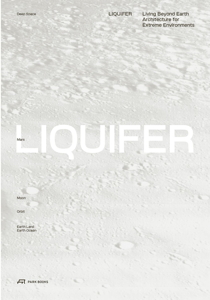 [2023]
[2023]
Living Beyond Earth: Architecture for Extreme
Environments
Edited by LIQUIFER Systems Group and
Jennifer Cunningham.
Published by Park Books, © 2023, 224 pages
ISBN: 978-3-038603450 (softcover)
[enlarge cover]
Order
Conquering the extremes: LIQUIFER Systems Group, a design and research firm
based in Vienna and Bremen, has been addressing the issue of human life on Earth
and elsewhere in the universe for two decades. Their work demonstrates how
consideration of technology-based design solutions and careful use of available
resources can enable us to live in space. Their concepts, feasibility
studies, and technological developments all deal with the key issue of scarcity
that defines life everywhere: on Mars, on the Moon, in orbit, as well as on
Earth. LIQUIFER Systems Group’s projects range from a simulated Mars
mission in Spain’s Rio Tinto region and the interior design for the habitation
module of the planned Gateway space station, to the EDEN ISS mobile greenhouse
in Antarctica and biogenerative studies in which microbes are integrated into
buildings to generate energy and recycle materials.
LIQUIFER. Living Beyond Earth is the first book to present the
practice’s groundbreaking work. It features spectacular images and
visualizations, detailed plans, and drawings that are supplemented with an
introduction by and a conversation between the LIQUIFER team, as well as a
prologue and an epilogue by renowned American space architects Brent Sherwood
and Christina Ciardullo. It enables the reader to delve into the visionary
world of Europe’s leading space design firms.
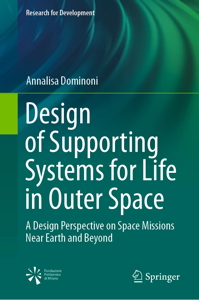 [2021]
[2021]
Design of Supporting Systems for Life in Outer
Space: A Design Perspective on Space Missions Near Earth and Beyond
By Annalisa Dominoni.
Published by Springer Nature, © 2021, 209 pages
ISBN: 978-3-030-60941-2 (hardcover)
ISBN: 978-3-030-60944-3 (softcover)
ISBN: 978-3-030-60942-9 (e-book)
[enlarge cover]
Order
This book is a rich source of information on design research and solutions
for the support and development of space missions. International
experiences and researches are presented in order to cast light on the role of
space design in improving living and working conditions in outer space and to
highlight the particularities of the necessary design skills, taking into
account specific requirements and constraints. The challenge facing
designers is how to approach environmentally extreme conditions in such a way
that they are transformed from limitations into opportunities. The author
has herself developed products that have been tested during on-orbit experiments
on the International Space Station. Drawing on this unique experience and
other case studies, the author proposes a new design methodology for space and
demonstrates how the discipline of design is able to generate innovation thanks
to the strong capacity of visioning. Ultimately this will lead to the
development of further new equipment for astronauts that will facilitate space
travel. While the book is intended primarily for students and researchers,
it is also of interest for a broad readership attracted by space, innovation,
and future scenarios.
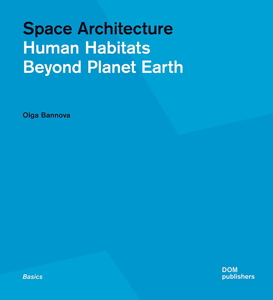 [2021]
[2021]
Space Architecture: Human Habitats Beyond Planet Earth
By Olga Bannova.
Published by DOM Publishers, © 2021, 240 pages
ISBN: 978-3-869226644 (softcover)
[enlarge cover]
Order
For many, the idea of Space Architecture as a discipline lies in the domain
of science fiction, where everything is possible simply because it happens “very
far in the future”. Is Space Architecture a fiction or reality?
This book explores if and how architectural principles and strategies need to
be transformed when applied to the extreme conditions of outer space. It
presents concepts developed by great minds in the fields of space exploration
and science-fiction, ones which can inspire new ways into the future.
The book also presents the philosophy of Space Architecture, arguing for
example that the design of space habitats needs to be human-centred while
defining ways for humans to co-exist in new environments. These views are
complemented by examples of architectures from current and planned space
missions, organised by private companies as well as government agencies.
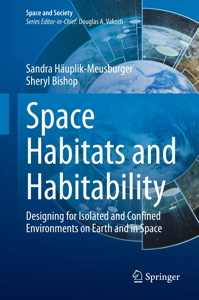 [2021]
[2021]
Space Habitats and Habitability: Designing for
Isolated and Confined Environments on Earth and in Space
By Sandra Häuplik-Meusburger and
Sheryl L. Bishop.
Published by Springer, © 2021, 250 pages
ISBN: 978-3-030-69739-6 (hardcover)
ISBN: 978-3-030-69742-6 (softcover)
ISBN: 978-3-030-69740-2 (e-book)
[enlarge cover]
Order
This book explores creative solutions to the unique challenges inherent in
crafting livable spaces in extra-terrestrial environments. The goal is to
foster a constructive dialogue between the researchers and planners of future
(space) habitats. The authors explore the diverse concepts of the term
Habitability from the perspectives of the inhabitants as well as the planners
and social sciences.
The book provides an overview of the evolution and advancements of designed
living spaces for manned space craft, as well as analogue research and
simulation facilities in extreme environments on Earth. It highlights how
various current and future concepts of Habitability have been translated into
design and which ones are still missing. The main emphasis of this book is
to identify the important factors that will provide for well-being in our future
space environments and promote creative solutions to achieving living spaces
where humans can thrive. Selected aspects are discussed from a
socio-spatial professional background and possible applications are
illustrated.
Human factors and habitability design are important topics for all working
and living spaces. For space exploration, they are vital. While
human factors and certain habitability issues have been integrated into the design process of manned spacecraft, there is a crucial need to move from mere
survivability to factors that support thriving. As of today, the risk of
an incompatible vehicle or habitat design has already been identified by NASA as
recognized key risk to human health and performance in space. Habitability
and human factors will become even more important determinants for the design of
future long-term and commercial space facilities as larger and more diverse
groups occupy off-earth habitats.
The book will not only benefit individuals and organizations responsible for
manned space missions and mission simulators, but also provides relevant
information to designers of terrestrial austere environments (e.g., remote
operational and research facilities, hospitals, prisons, manufacturing).
In addition it presents general insights on the socio-spatial relationship which
is of interest to researchers of social sciences, engineers and architects.
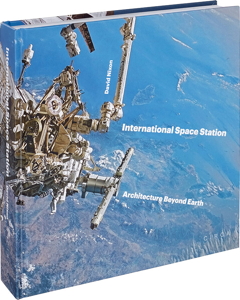 [2016]
[2016]
International Space Station: Architecture
Beyond Earth
By David A. Nixon.
Published by Circa Press, © 2016, 416 pages
ISBN: 978-0-9930721-3-0 (hardcover)
[enlarge cover]
Order
In 1984 President Ronald Reagan gave NASA the go-ahead to build a Space
Station. A generation later, the International Space Station is an
established and highly successful research centre in Earth orbit. The
history of this extraordinary project is a complex weave of powerful threads
– political, diplomatic, financial and technological among them –
but none is more fascinating than the story of its design. This book
provides the first comprehensive account of the International Space Station’s
conception, development and assembly in space. As a highly accessible
chronicle of a complex piece of design and engineering, it will appeal to
readers far beyond the space field.
NASA Astronaut Nicole Stott, a veteran of International Space Station
Expeditions 20 and 21 and Shuttle Missions STS-128, STS-129 and STS-133,
introduces the book with a personal memoir – “A Home in Space”.
David Nixon is an architect with a particular interest in designing for space exploration. In 1978 he cofounded Future Systems with Jan Kaplicky and was
among a handful of architects invited to work on the design of the
International Space Station. He later established an office in Los
Angeles to focus on work across the space field. In 2000 he formed
Astrocourier to develop miniature spaceflight experiments for schools.
This book is the result of seven years’ research.
“If you are a space fan, fascinated by the kind of venture the
International Space Station represents, this book is an absolute must, full of
juicy details and intriguing insights.”
— Popular Science, March 2016
“This book should be essential reading for a wide audience – anyone
who wants an insight into the field of human spaceflight in general, and the
International Space Station in particular.”
— Madhu Thangavelu, Sky at Night,
June 2016
“Arguably the best book available for a serious and deeply detailed analysis
of the origin, evolution, development and fabrication of the largest
international space endeavor yet mounted.”
— David Baker, Spaceflight, June 2016
“As a history of the planning, design, assembly and functioning of the Space
Station, this book is unlikely to be surpassed.”
— Andrew Crumey, Literary Review,
June 2016
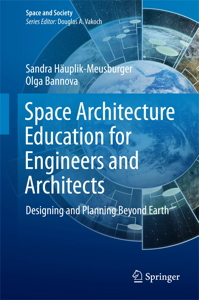 [2016]
[2016]
Space Architecture Education for Engineers and Architects: Designing and Planning Beyond Earth
By Sandra Häuplik-Meusburger and Olga Bannova.
Published by Springer, © 2016, 320 pages
ISBN: 978-3-319-19278-9 (hardcover)
ISBN: 978-3-319-79268-2 (softcover)
ISBN: 978-3-319-19279-6 (e-book)
[enlarge cover]
Order
This book considers two key educational tools for future generations of
professionals with a space architecture background in the 21st century: (1)
introducing the discipline of space architecture into the space system
engineering curricula; and (2) developing space architecture as a distinct,
complete training curriculum. Professionals educated this way will help
shift focus from solely engineering-driven transportation systems and “sortie”
missions towards permanent off-world human presence. The architectural
training teaches young professionals to operate at all scales from the “overall
picture” down to the smallest details, to provide directive intention –
not just analysis – to design opportunities, to address the relationship between human behavior and the built environment, and to interact with many
diverse fields and disciplines throughout the project lifecycle. This book
will benefit individuals and organizations responsible for planning
transportation and habitat systems in space, while also providing detailed
information on work and design processes for architects and engineers.
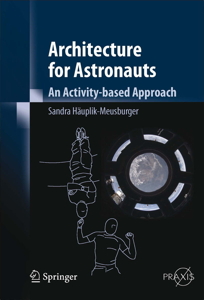 [2011]
[2011]
Architecture for Astronauts: An Activity-Based
Approach
By Sandra Häuplik-Meusburger.
Published by Springer, © 2011, 316 pages
ISBN: 978-3-7091-0666-2 (hardcover)
ISBN: 978-3-7091-1936-5 (softcover)
ISBN: 978-3-7091-0667-9 (e-book)
[enlarge cover]
Order
Living and working in extra-terrestrial habitats means being potentially
vulnerable to very harsh environmental, social, and psychological
conditions. With the stringent technical specifications for launch
vehicles and transport into space, a very tight framework for the creation of
habitable space is set. These constraints result in a very demanding
“partnership” between the habitat and the inhabitant.
This book is the result of researching the interface between people, space
and objects in an extra-terrestrial environment. The evaluation of
extra-terrestrial habitats in comparison to the user’s perspective leads
to a new framework, comparing these buildings from the viewpoint of human
activity. It can be used as reference or as conceptual framework for the
purpose of evaluation. It also summarizes relevant human-related design
directions. The work is addressed to architects and designers as well as
engineers.
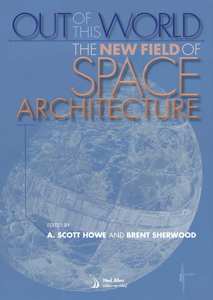 [2009]
[2009]
Out of This World: The New Field
of Space Architecture
Edited by A. Scott Howe and Brent Sherwood.
Published by AIAA, © 2009, 400 pages
ISBN: 978-1-56347-982-3 (hardcover)
ISBN: 978-1-56347-987-8 (e-book)
[enlarge cover]
Order
This collaborative book compiles thirty chapters on the theory and practice
of designing and building inhabited environments in outer space. Given the
highly visual nature of architecture, the book is rich in graphics including
diagrams, design drawings, digital renderings, and photographs of models and of
executed and operational designs.
Written by the global network of practicing space architects, the book
introduces a wealth of ideas and images explaining how humans live in space now,
and how they may do so in the near and distant future. It describes the
governing constraints of the hostile space environment, outlines key issues
involved in designing orbital and planet-surface architecture, surveys the most
advanced space architecture of today, and proposes far-ranging designs for an
inspiring future. It also addresses earth-based space architecture: space
analogue and mission support facilities, and terrestrial uses of space
technology.
In addition to surveying the range of space architecture design, from
sleeping quarters to live-in rovers to moon bases and space cities, the book
provides a valuable archival reference for professionals. Space
enthusiasts, architects, aerospace engineers, and students will find it a
fascinating read.
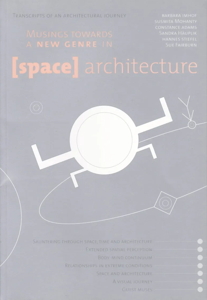 [2005]
[2005]
Transcripts of an Architectural Journey:
Musings Towards a New Genre in (Space) Architecture
By Barbara Imhof,
Susmita Mohanty,
Constance M. Adams,
Sandra Häuplik,
Hannes Stiefel, and
Susan M. Fairburn.
Published by LIQUIFER Systems Group, © 2005, 292 pages
[enlarge cover]
Order
“What
is space architecture? Admittedly, I still don’t know for sure. The
term seems to be a pleonasm since the designing of space actually is the goal of
architecture. Thus, space architecture is architecture tout court
– right?”
 [2025]
[2025]







